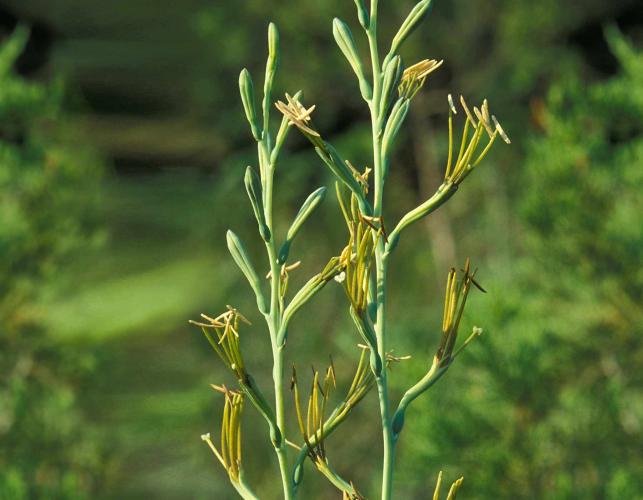
False aloe is a nonwoody perennial with a large basal rosette of soft, fleshy, flattened, sword-shaped leaves. The flowers are in a loose spike atop a long, leafless stalk; greenish yellow, to 1 inch long, tubular, 3-lobed, the tepals (3 petals and 3 petal-like sepals) fused at the bases, the stamens protruding. The fragrance is like that of Easter lilies. Blooms June–August, sometimes to October. The leaves are in a basal rosette, fleshy, dark green, sometimes with reddish-purple markings, lanceolate, pointed, with fine teeth along margins. The fruit is a round capsule.
Similar species: There are 3 species of Yucca in Missouri, and they are relatives of false aloe. They have leathery leaves, and their tepals (petals and sepals) are free, not fused at the base.
Height: flower stalk to 6 feet; leaves 2–16 inches long.

Common and widespread in the Ozarks, north to the Meramec River.
Habitat and Conservation
Occurs in glades, dry uplands, and open woodlands, usually in thin, rocky, alkaline soils, but also sometimes in sandy or cherty areas.
False aloe, and its relatives the agaves and yuccas (all New World plants), share many adaptations for survival in dry habitats and climates: the rosette of leaves channels rainfall toward the roots, and fleshy leaves store water and resist evaporation. The true aloes, unrelated and native to Africa, have evolved similar solutions to the same environmental challenges.
Status
Using DNA evidence, botanists have reorganized the plants once included in the lily family. One group within that family has become a separate family, the Asparagaceae (named for its representative genus, Asparagus). That family includes the agaves, yuccas, and false aloe, which have sometimes been given their own family, Agavaceae. True aloes, also once members of the lily family, are fairly unrelated; they are placed in a separate family and are native to Africa, not the New World.
Human Connections
With its interesting foliage, tall, long-flowering stalks, and fragrant flowers, false aloe is a good low-maintenance native wildflower for gardening. It’s perfect for sunny, rocky, well-drained, dry areas; try it in the back of a rock garden. Always get plants from reputable native plant nurseries; never dig them from the wild.
Ecosystem Connections
Moths, particularly sphinx moths and noctuid moths, pollinate this species at night, though bumblebees and hummingbirds visit the flowers, too.




























